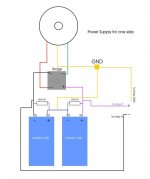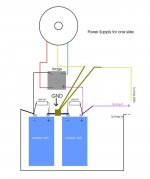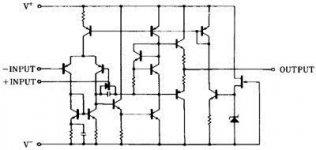Hi Quasi,
I built the Nmos500 and honestly speaking it sounds really amazing. Although I use 42 0 42 Transformer but sound is more than my expectation. Currently, I am listening Class D amp (Hypex) but I can not compare these two amps though but Nmos is amazing.
I really appreciate your effort and help you provided me.
Now, I am building the Nmos 350 and will share my experience as soon as I finish it. I am using irfp460 FETs in my new build.
I just told you my experience with Nmos500… any advice ... always welcome
Regards
Wasim
I built the Nmos500 and honestly speaking it sounds really amazing. Although I use 42 0 42 Transformer but sound is more than my expectation. Currently, I am listening Class D amp (Hypex) but I can not compare these two amps though but Nmos is amazing.
I really appreciate your effort and help you provided me.
Now, I am building the Nmos 350 and will share my experience as soon as I finish it. I am using irfp460 FETs in my new build.
I just told you my experience with Nmos500… any advice ... always welcome
Regards
Wasim
zerohead_ak47 said:
Hi Zerohead, I can't seem to open that file, I get a corrupted file message. I don't know if anyone else has had problems with it but could you email the file to me? quasiweb@adam.com.au
Cheers
Q
Hi i got a problem !!!🙁
My amp works really well but suddenly it stops working and the 220R resistors blew away. I have been testing it for last one month and I did not get any problem. I do not know what happened. I replaced the resistors and turn it on but the resistors have gone again. Is there anyone who can tell me what mistake I have made in Nmos500?
I am using 42 0 42 Transformer and getting around 59VDC rail.
Regards
My amp works really well but suddenly it stops working and the 220R resistors blew away. I have been testing it for last one month and I did not get any problem. I do not know what happened. I replaced the resistors and turn it on but the resistors have gone again. Is there anyone who can tell me what mistake I have made in Nmos500?
I am using 42 0 42 Transformer and getting around 59VDC rail.
Regards
Wasim said:Hi i got a problem !!!🙁
My amp works really well but suddenly it stops working and the 220R resistors blew away. I have been testing it for last one month and I did not get any problem. I do not know what happened. I replaced the resistors and turn it on but the resistors have gone again. Is there anyone who can tell me what mistake I have made in Nmos500?
I am using 42 0 42 Transformer and getting around 59VDC rail.
Regards
Ouch! Can you please post photos of your complete build, including power supply, amp modules, case, heatsinking etc.
Cheers
Q
hei quasi .....
havent seen you for long time .....
i presume you ve been too busy to bother with the pcb
just trying to remind you ....when ever you have the time though ....
thanks sakis athens
havent seen you for long time .....
i presume you ve been too busy to bother with the pcb
just trying to remind you ....when ever you have the time though ....
thanks sakis athens
quasi said:
Ouch! Can you please post photos of your complete build, including power supply, amp modules, case, heatsinking etc.
Cheers
Q
Hi Dear Quasi,
I have not built any case yet. I place the amps on the heatsinks as you mentioned in the construction guide. I am attaching picture of my setup. I actually disconnected it that’s why I am showing merely one channel.
I have used the transformer of my powerpod mixer.
I have used the two 1/4w mf resistors in parallel instead of one 0.5w throughout the Nmos.
When the resistor (220R) burnt I was using 2ohm speakers and the main heatsink was very hot even its fins were very hot.
Regards
Attachments
Hi Wasim,
Two thoughts come to mind.
1. Is that heat sink grounded? If not, it can create unwanted coupling between amplifier stages and create an oscillation.
2. Are you running the amp with the fins on the heat sink down as in your picture? The air must be able to flow up through the fins.
-Chris
Two thoughts come to mind.
1. Is that heat sink grounded? If not, it can create unwanted coupling between amplifier stages and create an oscillation.
2. Are you running the amp with the fins on the heat sink down as in your picture? The air must be able to flow up through the fins.
-Chris
Hi Wasim,
If the main heatsink including the fins was too hot to hold then I suspect that the output stage just got too hot and died.
Mosfet amps of this design will run hotter than their bi-polar counterparts so big heatsinks are required.
You will need to measure each FET to determine how many have failed and replace them, maybe you need to replace the lot if they suffered severe thermal stress.
As Chris has suggested the heatsink should be oriented so the fins are vertical and it should also be grounded either by a chassis connection or a lead to ground.
Anyway my final thought is that the heatsink you have used is too small for driving into a 2 ohm load so replace it with a larger one and add a fan.
Sorry & Cheers
Quasi
If the main heatsink including the fins was too hot to hold then I suspect that the output stage just got too hot and died.
Mosfet amps of this design will run hotter than their bi-polar counterparts so big heatsinks are required.
You will need to measure each FET to determine how many have failed and replace them, maybe you need to replace the lot if they suffered severe thermal stress.
As Chris has suggested the heatsink should be oriented so the fins are vertical and it should also be grounded either by a chassis connection or a lead to ground.
Anyway my final thought is that the heatsink you have used is too small for driving into a 2 ohm load so replace it with a larger one and add a fan.
Sorry & Cheers
Quasi
Hi dear Chris & Quasi,
Thanks a lot for the reply. I understand that I will try to get new and large heatsinks.
One thing can I use wire to ground the heaksink with powersupply ground?
If I use two1/4resistors in parallel is it fine because otherwise I have to order it from US they are not available here in Pakistan local electronic stores 😉.
Regards
Thanks a lot for the reply. I understand that I will try to get new and large heatsinks.
One thing can I use wire to ground the heaksink with powersupply ground?
If I use two1/4resistors in parallel is it fine because otherwise I have to order it from US they are not available here in Pakistan local electronic stores 😉.
Regards
Hi Quasi,
One more thing if the out put FETs get very hot they may burn the resistors? because in my case the 220R resistor caught fire and burnt.
Regards
One more thing if the out put FETs get very hot they may burn the resistors? because in my case the 220R resistor caught fire and burnt.
Regards
Hi Wasim
You can use single 1/4 resistors for most (not all) parts of the amplifier. I specified 0.5 watt beacuse this is a common rating for metal film resistors. For example the 220 watt resistors providing the voltage drive for the output stage only dissipate an average of 0.072 watts. This is calculated by (18mA)² x 220 ohms.
The 220 ohm resistors could have failed for several reasons. A probable one is a shorted drain-gate junction in the FETs. In this case the full rail voltage would have been applied across the resistor. I'm not saying this is what happened it's just an axample, you will need to find out what the actual fault is or was.
Yes you can connect the heatsink to the power supply central ground with a single wire if you like. This is not needed if the heatsinks form part of a completed metal case.
Cheers
Q
You can use single 1/4 resistors for most (not all) parts of the amplifier. I specified 0.5 watt beacuse this is a common rating for metal film resistors. For example the 220 watt resistors providing the voltage drive for the output stage only dissipate an average of 0.072 watts. This is calculated by (18mA)² x 220 ohms.
The 220 ohm resistors could have failed for several reasons. A probable one is a shorted drain-gate junction in the FETs. In this case the full rail voltage would have been applied across the resistor. I'm not saying this is what happened it's just an axample, you will need to find out what the actual fault is or was.
Yes you can connect the heatsink to the power supply central ground with a single wire if you like. This is not needed if the heatsinks form part of a completed metal case.
Cheers
Q
"Yes you can connect the heatsink to the power supply central ground with a single wire if you like. This is not needed if the heatsinks form part of a completed metal case."
I believe that might not be effective at the high frequencies where oscillation could occur. A small cap (or direct wire) connected from heatsink to decoupling ground on the board will probably be a better idea.
I believe that might not be effective at the high frequencies where oscillation could occur. A small cap (or direct wire) connected from heatsink to decoupling ground on the board will probably be a better idea.
ravslanka said:hi quasi
matching pre amplifier for nmos350 please
iam playing the amp directly from computer sound card
NMOS350 has got input impedance 33 kohm
the voltage gain is x33 (33k/1k)
For 66 Volt peak output, you need 1.4 Volt RMS input.
The gain you need from one CD-player output, to get almost max output swing into NMOS350
is MAX x2 (+6 dB)
.... calculated with a voltage peak of 1.0 Volt (=0.7 Volt RMS) from your CD-disc.
Gv = 2.0 into 33 kohm .. any op-amp can do this.
One standard OPA2134 (dual JFET) would do this very well, into both your channels.
-------------------------
For other sources than CD, like soundcard
you maybe would want a gain of x4 (+12dB)
or even x10 (+20dB) .... for absolute max output from NMOS350
In this case I understand you are the owner of a Big Disco Resturant in some India city 😀
Neither this is any problem for one OPA2134 opamplifier.
Lineup
Hi Quasi,
I understand that thanks again. Let me build the amp again and then I will share the picture of my new setup.
Regards
Wasim
I understand that thanks again. Let me build the amp again and then I will share the picture of my new setup.
Regards
Wasim
lineup said:
NMOS350 has got input impedance 33 kohm
the voltage gain is x33 (33k/1k)
For 66 Volt peak output, you need 1.4 Volt RMS input.
The gain you need from one CD-player output, to get almost max output swing into NMOS350
is MAX x2 (+6 dB)
.... calculated with a voltage peak of 1.0 Volt (=0.7 Volt RMS) from your CD-disc.
Gv = 2.0 into 33 kohm .. any op-amp can do this.
One standard OPA2134 (dual JFET) would do this very well, into both your channels.
-------------------------
For other sources than CD, like soundcard
you maybe would want a gain of x4 (+12dB)
or even x10 (+20dB) .... for absolute max output from NMOS350
In this case I understand you are the owner of a Big Disco Resturant in some India city 😀
Neither this is any problem for one OPA2134 opamplifier.
Lineup
hi lineup
thanks for your comments
a circuit would be appreciated using jrc4558/tl062 i have plenty of
these opamps
btw
iam a student of b.tech civil engg.i do not own a disco theqe or resturaunt
thanks in advance
Wasim said:hi,
I have some big capacitors and I want to use them. Plz have a look at the attachment and tell me will it work?
Regards
Proper PSU wiring (see attachment!).
Attachments
ravslanka said:
hi lineup, thanks for your comments
a circuit would be appreciated using jrc4558/tl062
i have plenty of these opamps
I would say maybe JRC4558 (NJM4558) is the better one.
Has been replaced by NJM4560, which is a very good op-amp for upgrade.
Read this PDF:
http://www.electrokit.se/download/NJM4560_E.pdf
GENERAL DESCRIPTION
The NJM4560 integrated circuit is a high-gain,wide bandwidth,dual operational amplifier
capable of driving 20V peak-to-peak into 400Ω loads.
The NJM4560 combines many of the features of the NJM4558 as well as providing the capability of wider bandwidth,and higher slew rate
make the NJM4560 ideal for active filters,data and telecommunications,and many instrumentation applications.
TL062 is JFET input and just as good as wellknown TL072,
which is not at all a bad audio op-amp.
From which follows that TL062 is not a bad audio operational amplifier.
(they are not the best .. but they are good for many general audio circuits)
Regards
=====================
NJM4560 Op-Amp, Equivivalent Circuit (simplified)
Attachments
lineup said:
I would say maybe JRC4558 (NJM4558) is the better one.
Has been replaced by NJM4560, which is a very good op-amp for upgrade.
Read this PDF:
http://www.electrokit.se/download/NJM4560_E.pdf
TL062 is JFET input and just as good as wellknown TL072,
which is not at all a bad audio op-amp.
From which follows that TL062 is not a bad audio operational amplifier.
(they are not the best .. but they are good for many general audio circuits)
Regards
=====================
NJM4560 Op-Amp, Equivivalent Circuit (simplified)
hi lineup
appreciate your comments
bu i need a pre amp schematic using opamps
thanks in advance
- Home
- Amplifiers
- Solid State
- Power amp under development



